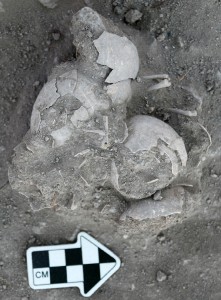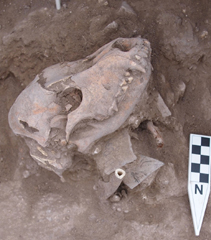Zooarchaeology of the Prehispanic Zapotec
| The Valley of Oaxaca in southern Mexico has a long and complex history of human occupation and animal use, beginning more than 10,000 years ago. Human-animal relationships changed significantly throughout this time, with the earliest occupants hunting a wide variety of animals to fulfill their subsistence needs. By the Classic period, Zapotec meat diet relied largely on three to four main animals—deer, dog, rabbits, and eventually turkey—but each settlement had its own unique zooarchaeological signature. Site-specific animal specialties and preferences emerged as households and communities chose to specialize in the production of certain animals and animal by-products.
The studies discussed below are a culmination of more than ten years (2007-2016) of zooarchaeological analysis at four sites: El Pamillo, Mitla Fortress, Lambityeco, and Cerro-Danush. This research was completed in collaboration with the Zapotec Archaeology Project co-directed by Dr. Gary Feinman and Linda Nicholas (The Field Museum) and the Dainzú-Macuilxóchitl Project directed by Dr. Ronald Faulseit (Pierce College). |
Rabbit Raising at El PalmilloAt El Palmillo, the ancient Zapotec exploited rabbits as a food source, used their hair in textile production, and incorporated rabbits into ritual practices. Cottontail rabbits, in particular, became a favored animal resource among high-status families. Elite refuse contained the greatest amounts of rabbit skeletal remains, and ritual offerings of rabbits were restricted to these residences. Higher-status households also produced textiles using fine maguey and possibly cotton thread that likely incorporated rabbit hair. The best source of rabbit fur would have been from live animals kept near the residence. This leads to the question, were some households raising captive rabbits? Further research is required to answer this question; but, the zooarchaeology at El Palmillo provides solid evidence for rabbit specialization among elite families in the community. Read more… Animal economies in Pre-Hispanic southern Mexico. |
 |
 |
Turkey Domestication at the Mitla FortressRecent excavations at the Mitla Fortress have produced the earliest and most comprehensive evidence to date of turkey domestication among the ancient Zapotecs. Two Classic to Early Postclassic period (ca. AD 300–1200) domestic residences have yielded the remains of juvenile and adult turkeys (both hens and toms), along with an egg-laying hen and unhatched and hatched turkey eggs (ranging from unfertilized or newly fertilized eggs to eggs nearing the termination of embryogenesis to hatched poults). Turkeys were used in rituals, and turkey bones were modified for use as tools and crafted into items of personal adornment. These data provide the earliest, unequivocal evidence that turkeys were being raised and kept by some families at the Mitla Fortress. Read more… Turkey husbandry and use in Oaxaca, Mexico. |
For More Information…Inquiries about zooarchaeology in the Valley of Oaxaca, please contact Dr. Heather Lapham. To read more about archaeology at the aforementioned sites, check out the following sources: Expeditions at the Field Museum — El Palmillo and Mitla Fortress The Ballcourt at El Palmillo: Implications for Late Classic Oaxaca, Mexico by Gary Feinman and Linda Nicholas Spindle Whorls from El Palmillo: Economic Implications by Lacey Carpenter, Gary Feinman, and Linda Nicholas The Missing Femur at the Mitla Fortress and its Implications by Gary Feinman, Linda Nicholas, and Lindsey Baker Cerro Danush: Excavations at a Hilltop Community in the Eastern Valley of Oaxaca, Mexico by Ronald Faulseit. This book is available from the University of Michigan and Amazon.com. |


